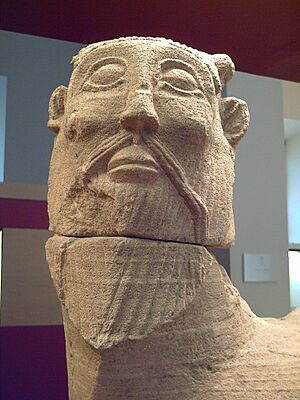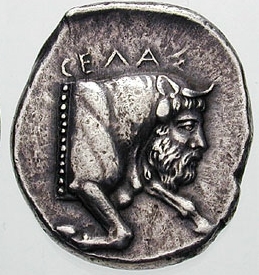Bicha of Balazote facts for kids

The Bicha of Balazote is a very old and special Iberian sculpture. It was found in a town called Balazote in Albacete province, Spain. Some people, like writer Carlos Fuentes, have called it the "Beast of Balazote." This amazing statue was made around 600 BCE, which is about 2,600 years ago! Since 1910, it has been kept safe at the National Archaeological Museum of Spain in Madrid.
Contents
Where Was It Found?
The Bicha was discovered at a place called Majuelos, close to the center of Balazote. Recently, archaeologists have been digging in the Balazote plain. They found an ancient tomb and a burial mound nearby. It's possible the Bicha originally came from this burial site. Not far from there, they also found beautiful Roman villa mosaics.
What Does the Bicha Look Like?
The Bicha is carved from two large blocks of limestone. It is about 93 centimeters (3 feet) long and 73 centimeters (2.4 feet) high. It's a unique mix of a man and a bull, sometimes called a "chimera." The body looks like a bull resting, with its front legs tucked under its chest. Its back legs are also folded under its belly. The tail curls over its left thigh and has a tuft of hair at the end.
The Head of the Bicha
The head of the Bicha is very interesting. It has the face of a bearded man, but with bull's horns and ears. The way the hair and beard are carved, with straight lines, is similar to an old style of Greek art. This style is known as "archaic Greek hieratic sculpture," which means it's a very formal and ancient Greek way of carving.
What Was Its Purpose?
The Bicha is not carved all the way around like some statues. One side looks like it was meant to be attached to something, perhaps a wall. This is similar to the lion statues found at the Mausoleum of Pozo Moro. Experts think it might have been part of a tomb or a temple.
A God of Fertility?
Some people believe the Bicha might represent a god of fertility. This means a god who helps plants grow and makes the land rich. The ancient Greeks sometimes used statues of man-headed bulls to show river gods. These river gods were believed to make the fields fertile with their waters.
According to some historians, like A. García and Bellido, the Bicha could represent the Greek river god Achelous. The Bicha looks a bit like images of Achelous found on old Sicilian coins. In 1931, A. García and Bellido said that this sculpture was influenced by Greek art, and even older Phoenician and Mesopotamian art.
See also
 In Spanish: Bicha de Balazote para niños
In Spanish: Bicha de Balazote para niños



